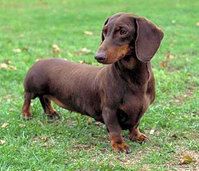Cushing’s Disease in Dogs.
Cushing’s disease is a condition fairly common in middle aged and older dogs and is often overlooked as simply being part of the ageing process. This Holidays4Dogs article will provide information on signs and symptoms to watch out for and treatments available.
There are several different forms of Cushing’s disease. The most frequent form of the disease is caused by the overproduction of a hormone produced by the pituitary gland in the brain. This, in turn, causes the adrenal gland to produce an excess of glucocorticoid hormones needed for the correct function of different organs in the body.
This form is referred to as pituitary dependent hyperadrenocorticism (PDH) and presents in 80% of Cushing’s cases. If the disease is adrenal based, this usually indicates an adrenal tumour and is responsible for 20% of cases.
There are a few breeds more prone to developing Cushing’s disease. These include, boxers, poodles, beagles, dachshunds and Staffordshire bull terriers. However, any breed of dog can be affected.
Symptoms can be wide ranging and usually gradual in onset. This is why many dogs are not diagnosed, since it is often wrongly assumed the dog is simply showing natural signs of ageing, or some other common canine condition.
The most common signs of Cushing’s include;
Hair loss – this usually occurs on the dog’s torso and is common in around 50% to 90% of cases. The skin is not usually itchy. Sometimes, the skin becomes noticeably thinner and may bruise more readily.
Increased appetite, thirst, along with an increase in the need to urinate.
Appearance of a ‘pot belly’- usually as a result of fat deposited in the abdominal area and a weakening of the stomach muscle.
Other less common symptoms include;
Abnormal gait.
Chronic onset of difficulty in breathing, which may indicate a blood clot to the lungs.
Diagnosis of Cushing’s disease.
Unfortunately, there is no single test that can confirm the presence of Cushing’s disease, This is because of the broad way in which it can affect individual dogs.
There is some controversy surrounding the testing for Cushing’s disease. As well as this, there is likely to be genetic variation on how the individual dog responds to elevated levels of hormones.
In addition, unless there is strong clinical physical evidence for the disease, tests cannot automatically assumed to be valid. Therefore, a detailed history and physical examination is vital.
It is also important the tests take into account the differences between the two most common forms of Cushing’s disease, as treatment may vary.
It is also possible for some animals to develop Cushing’s as a result of taking cortisol based medication over a long period of time; (often prescribed for autoimmune, or allergic diseases, for instance). Occasionally, topically applied steroids can cause symptoms associated with Cushing’s disease.
Depending on the type of disease the dog has, there are different appropriate treatment options to follow. If the disease is adrenal based and a tumour is found, surgery is the most likely option. However, because the majority of dogs suffer from the pituitary type, non surgical intervention is the most likely option.
Available Medications.
Lysodren (also called Mitotane) – this works rather like a chemotherapy drug by destroying cells in the adrenal gland. Therefore, even though the pituitary gland is still overproducing, it is less able to respond to the excess of hormones.
Trilosane – a relatively new treatment for Cushing’s disease and a little more expensive.
Ketoconazole – this treatment is not often used today but was a common treatment with veterinarians around the 1980’s as an anti fungal agent.
Alternative Treatments and Medication.
Dogs do not develop the disease over night, but over a long period of time. Certain natural and homeopathic remedies are reputed to normalise the production of cortisol. Therefore, this is an avenue that owners may also wish to explore further. Consult a qualified homeopathic vet for further advice.
Dandelion – helps stabilise function of the adrenal glands, as well as being a tonic for the kidneys and liver.
Burdock – a herb which detoxifies and eliminates unwanted substances and balances blood sugar levels.
Arsenicum – for excessive thirst and urination.
Hepar Sulph – useful for treating infections and irritated skin.
Astragalus – helps strengthen the immune system and assists with adrenal balance. Also regulates blood pressure and blood sugar levels.
Diet – a good diet is of primary importance by providing the dog with the correct balance of nutrients for body function.
Conclusion.
The most important thing is to seek veterinary advice as soon as you suspect your dog may be showing indications of Cushing’s disease. Early intervention and professional advice is essential. Treating this disease can be a balancing act and requires regular and careful monitoring by vet and owner. However, dogs frequently make a good recovery – going on to have many more years of good quality life.


